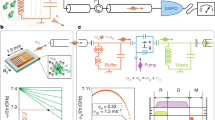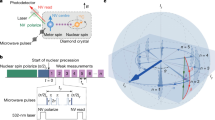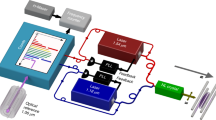Abstract
MAGNETIC resonance spectroscopy1 is a powerful tool for molecular characterization and structure determination. The sensitivity of conventional approaches is limited to about 1010 electron spins or 1016 nuclear spins; this sensitivity can be improved to about 105 spins by polarizing the spins via optical pumping and detecting optical rather than microwave photons2. Recently, fluorescence from single molecules was detected by tuning a single-frequency laser in the inhomogeneously broadened fluorescence excitation band of a dilute dispersion of pentacene in a host crystal of p-terphenyl3,4. Here we report that, by combining single-molecule fluorescence spectroscopy with optically detected magnetic resonance for the pentacene-doped p-terphenyl system, we can detect magnetic resonance in a single pentacene molecule. We observe two of the three possible transitions between sublevels of the metastable triplet state. The spectral lineshapes indicate that the proton nuclear spin states change during the measurement, leading to spectral diffusion within the magnetic resonance line.
This is a preview of subscription content, access via your institution
Access options
Subscribe to this journal
Receive 51 print issues and online access
$199.00 per year
only $3.90 per issue
Buy this article
- Purchase on Springer Link
- Instant access to full article PDF
Prices may be subject to local taxes which are calculated during checkout
Similar content being viewed by others
References
Abragam, A. The Principles of Nuclear Magnetism (Oxford Univ. Press, London, 1961).
Suter, D. J. Magn. Reson. 99, 495–506 (1992).
Orrit, M. & Bernard, J. Phys. Rev. Lett. 65, 2716–2719 (1990).
Ambrose, W. P. & Moerner, W. E. Nature 349, 225–227 (1991).
Bernard, J., Fleury, L., Talon, H. & Orrit, M. J. chem. Phys. 98, 850–859 (1993).
Clark, R. H. (ed.) Triplet State ODMR Spectroscopy (Wiley, New York, 1982).
Ambrose, W. P., Basché, Th. & Moerner, W. E. J. chem. Phys. 95, 7150–7163 (1991).
van Strien, A. J. & Schmidt, J. Chem. Phys. Lett. 70, 513–517 (1980).
Sloop, D., Liu, H. L., Lin, T. S. & Weissman, S. I. J. chem. Phys. 75, 3746–3757 (1981).
de Vries, H. & Wiersma, D. A. J. chem. Phys. 70, 5807–5822 (1979).
Hutchison, C. A. Jr, Nicholas, J. V. & Scott, G. W. J. chem. Phys. 53, 1906–1917 (1970).
Stehlik, D. in Excited States (ed. Lim, E. C.) Vol. 3, 204 (Academic, New York, 1977).
von Borczyskowski, C. in Advances in Magnetic Resonance (ed. Waugh, J.) Vol. 12, 113 (Academic, New York, 1988).
Author information
Authors and Affiliations
Rights and permissions
About this article
Cite this article
Wrachtrup, J., von Borczyskowski, C., Bernard, J. et al. Optical detection of magnetic resonance in a single molecule. Nature 363, 244–245 (1993). https://doi.org/10.1038/363244a0
Received:
Accepted:
Issue Date:
DOI: https://doi.org/10.1038/363244a0
This article is cited by
-
Single-electron spin resonance detection by microwave photon counting
Nature (2023)
-
Single-molecule electron spin resonance by means of atomic force microscopy
Nature (2023)
-
Perspective: nanoscale electric sensing and imaging based on quantum sensors
Quantum Frontiers (2023)
-
Electron spin resonance of single iron phthalocyanine molecules and role of their non-localized spins in magnetic interactions
Nature Chemistry (2022)
-
Wide-field magnetometry using nitrogen-vacancy color centers with randomly oriented micro-diamonds
Scientific Reports (2022)
Comments
By submitting a comment you agree to abide by our Terms and Community Guidelines. If you find something abusive or that does not comply with our terms or guidelines please flag it as inappropriate.



